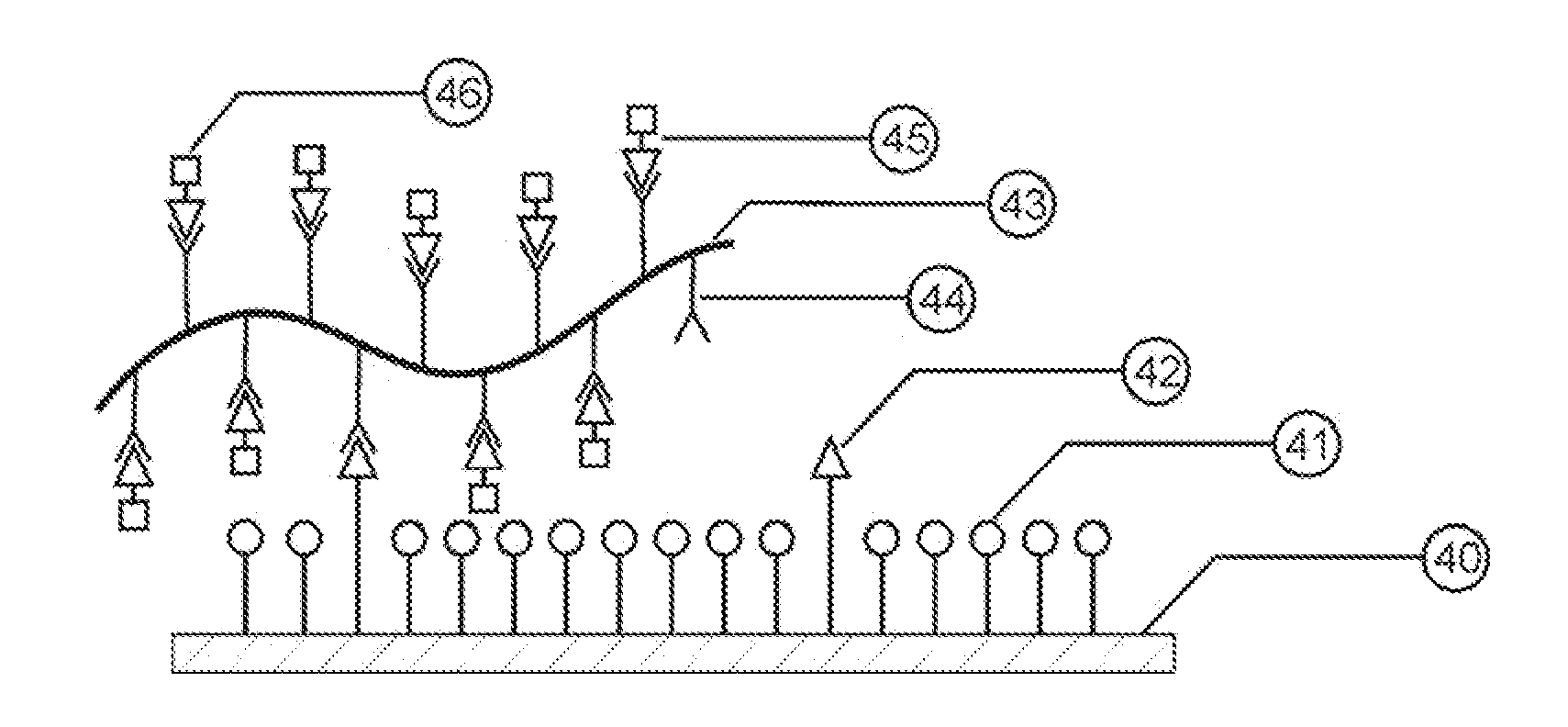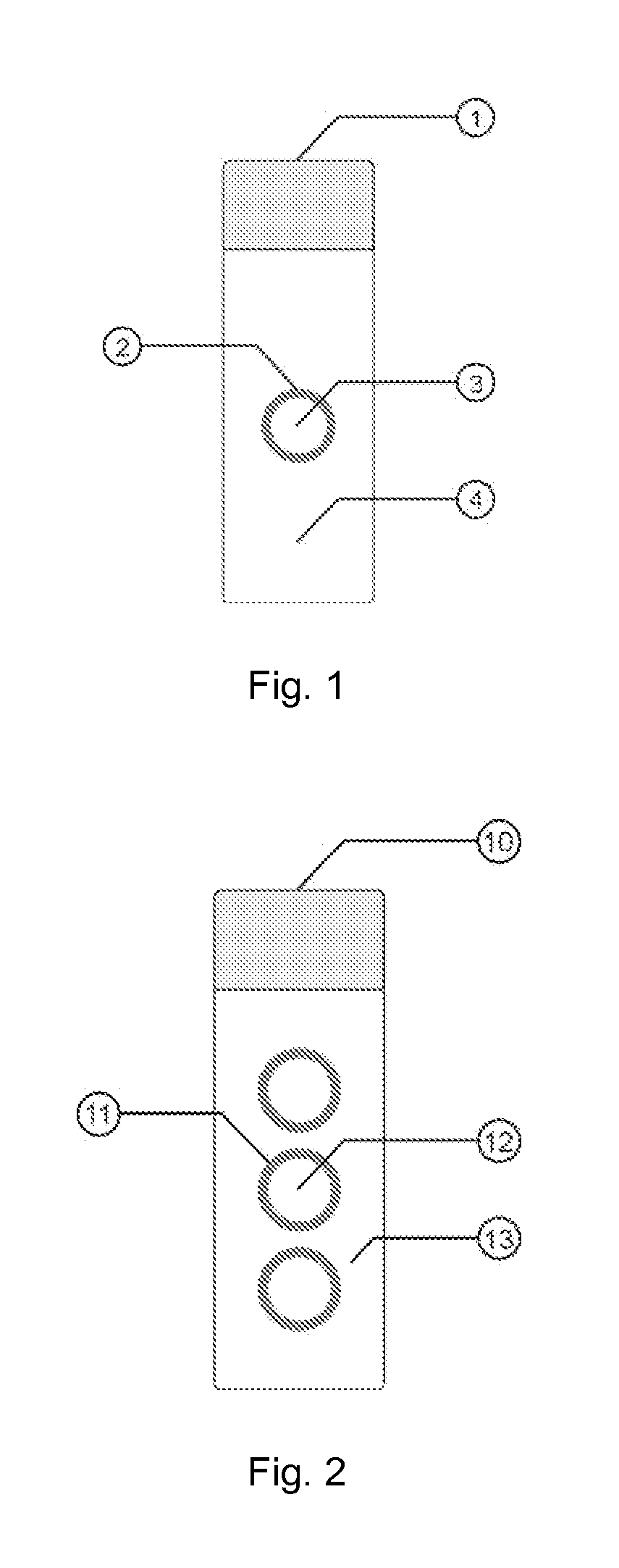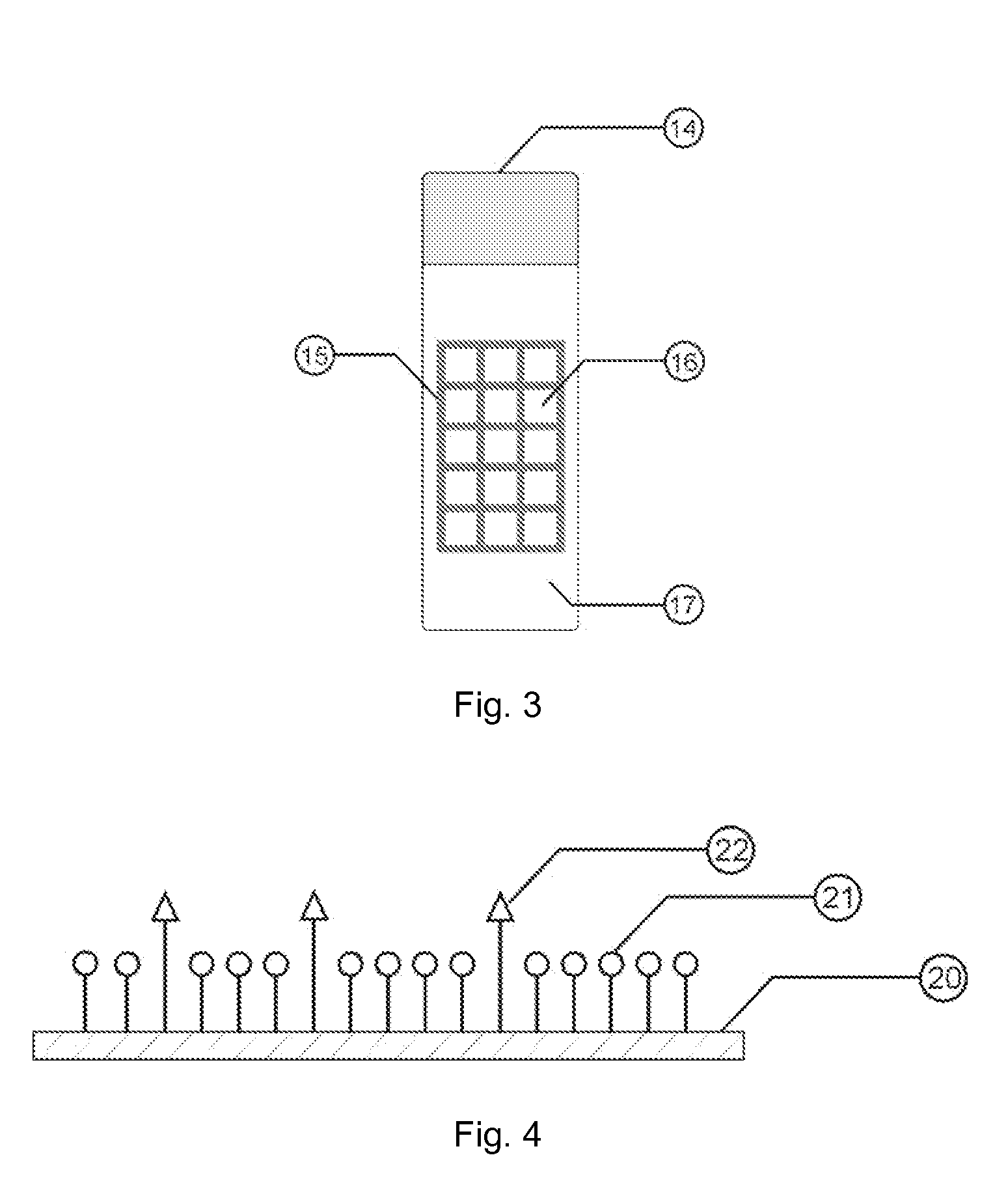[0013]For the most part, the reactive
silanes used to attach
biological materials (
protein / peptides, cells, and tissue) to slides react with a
biomaterial's amine or carboxyl sites. While there are typically a great many amine sites on the
biological materials, the density is much lower than the spacing between the silane molecules on the glass surface. However, if covalent bonds are formed, 100% binding density is not required to ensure the
biomaterial is sufficiently anchored to the glass. Therefore, the opportunity exists wherein spacer
silanes can be used to separate the reactive binding silanes and influence the overall hydrophilic / hydrophobic behavior of the surface. The spacer silanes are chosen such that they have a shorter terminal end spacer arm than the reactive silanes. The resulting mixture forms a 3-D structure on the slides, which contains isolated
covalent binding sites surrounded by hydrophobic / hydrophilic spacers. The 3-D reactive structure depth can be enhanced by
grafting a
reactive polymer chain to the
covalent binding silane sites. This increased depth provides a conformal binding mechanism that draws in tissue samples as it dries with continued binding attachment. More importantly for
protein deposits, the
polymer strand will tend to wrap itself around the protein, which greatly retards the protein's ability to uncoil if denaturing stimulus is applied. There is a limitation on the length of the
polymer chain; if too long, the
polymer chain will fall over and hinder the wettability provided by the hydrophilic spacers. Thus, the polymer strand length should be shorter than the spacing between the reactive silane binding sites.
[0019]Generally, all biomaterial reactive moieties are hydrophobic, which can lead to the formation of micro-bubbles and initial skittish behavior of the
tissue section on the slide. Micro-bubbles form on a hydrophobic surface because upon entrance of the slide into the bath, the liquid cannot fully displace the air trapped in the porous structure. Micro-bubbles remaining between the
coating and the
tissue section will usually form voids. These voids will rupture the tissue during the HIER process and can cause loss of tissue if not eliminated. It is desirable then to apply a temporary non-reactive hydrophilic topcoat to the slide. This surface treatment ensures that the slide will not support micro-bubble adhesion when initially placed into the sectioned tissue bath as well as promote fast draining of the water, which allows the tissue to settle down onto the slide surface before it can dry and be left with a lifted portion. An additional benefit of the surface treatment is that the reactive silane moieties are generally encapsulated and thus protected from unintended reactions with airborne
contamination prior to the application of a
tissue section. Such a material could be a
short length hydrophilic polymer. The polymer is released into the sectioned tissue bath upon immersion, where it remains effectively
inert to any
tissue sections because of the very low concentration density. The application of such a hydrophilic material onto a hydrophobic surface would normally cause the hydrophilic material to be disassociated and rejected from the slide unless applied correctly.
[0020]For protein /
peptide /
enzyme deposits a different set of conditions arise. When these biomaterials are deposited, they are carried in a printing buffer
slurry. The attributes of the buffer and the structure of the slide coating must work together to enable monotonic single layer deposits. Because the biomaterials are so small, the movement of the
slurry is affected by the height modulation,
porosity,
Zeta potential of the biomaterials, and the
viscosity, and pH of the buffer. If a single-silane coating is used, the biomaterials tend to be repelled by the coating to give the appearance that the coating is strongly hydrophobic. If another long spacer arm hydrophobic silane is added at a low concentration, it acts to stop the movement of the
slurry from excessive spreading before capture can take place. This behavior is realized because there is sufficient obstruction of the slurry movement that the buffer is able to drop into the
porosity and leave the biomaterial stranded above. Balance must be reached between the coating and the slurry such that this can occur. Very large deposits, one
centimeter (1 cm) in
diameter, are possible as a uniform and round single layer with very crisp edge detail.
[0048]These materials enable the user to push the surface wettability lower, more hydrophobic, while keeping the reactive silanes spaced sufficiently.
[0064]Assuming for the moment that the density of
epoxide sites is higher than whatever amine structure exists on a biomaterial, to obtain the highest efficiency in bonding density, the pH of the solution that contains the biomaterials would need to be at least 9.0. For tissue mounting, this presents no particular constraints, but for protein /
peptide deposits this greatly affects the
wetting ability of the slurry and thus results in non-uniform shape dots and uneven biomaterial density. However, if a
wetting agent is added to the protein slurry, then the pH can be decreased to 6-7 and the
wetting performance will remain high, resulting in uniform shape dots and biomaterial density.
 Login to View More
Login to View More 


